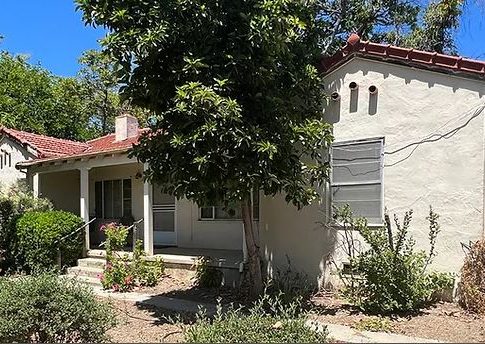By Jana Monji
Note: This recap contains spoilers
LATEST STORIES

This episode, The Weak Are Meat, begins with Chester already deployed on a tropical Pacific island, writing letters to his girlfriend. Back in the US, his future baby’s mother, Luz, is writing back to Chester as her pregnancy nears an end.
The title of this episode comes from an old Japanese/Chinese saying: jaku niku kyō shoku (弱肉強食). The meaning is literally, “The weak are meat; the strongest eat” and can be translated as “survival of the fittest.”
In a tent with Arthur Ogawa, Chester spends “all day translating documents and fighting off malaria,” but he still hasn’t shaken that mysterious malaise–the suspicion that supernatural forces are drawn to him.
Chester asks Arthur about yūrei. Arthur is skeptical and all Arthur knows about the yūrei is “what I read in those old Kaiden stories,” and notes that it “depends upon its onnen–crazed hunger for something” and that the yūrei will spend the “rest of eternity trying to satisfy its onnen.”.
Later, Arthur and Chester are taken to the scene of a battle, during which they pass a White US service man carving a bone as he sits beside a defleshed skull on a stake. When they finally reach the site, they see a muddy pit filled with dead Japanese soldiers.
A White officer tells the Chester and Arthur, “Thought it might be time for you to see where your documents are coming from.”
The military are interested in Admiral Takahashi and the action didn’t “get nasty until six days ago” and that’s when they lost Sergeant Silas Crittenden. No one is sure if Crittenden is alive but they fear he might be tortured.
Chester angrily replies, “You know if your boys weren’t busy making letter openers out of shinbones they might have realized a live prisoner would stand a better chance of telling us where Admiral Takahashi is.” Chester is sent down into the mud pit and finds wabun code on a belt. The White soldiers are then told to “get in there chop chop” and find more leads. With Chester’s help, the soldiers eventually find Crittenden, but Crittenden seems to suffer from shell-shock or perhaps he is possessed by a spirit. .
The White soldiers don’t totally accept Arthur and Chester. Later, when a group of White soldiers find Chester alone, they begin to beat him up. One of them urges Crittenden to join in, saying “Sarge, get in here. This is for you.” But the sergeant turns on the flame thrower and burns all of his soldiers. The only one left alive is Chester because the White soldiers who fell on top of him sheltered him from the flames.
Another soldier takes the flame-thrower from Crittenden who seems dazed and doesn’t seem to realize what he has done. In Japanese, Chester asks Crittenden if he’s a yūrei. In Japanese, Crittenden responds with “kill the White demons” and that he serves Admiral Takahashi.
Back at Colinas de Oro in Oregon, the women are tending their garden plots as Luz reads Chester’s letter. Luz shows Chester’s mother a photo of Chester in uniform. Although Chester’s mother tells Luz not to be afraid, Luz is afraid she will die like her mother did giving birth to her.
Asako tells her, “You need to think good thoughts.”
Luz asks, “How was it when you gave birth to Chester?”
Asako replies, “I don’t remember. It was so long ago.” If you recall, Asako had heard about a midwife in the new barracks and at the end of the last episode, Luz was seeing her and in this episode, the midwife, Yūko has given her a toy.
Now a White soldier goes to that row of barracks (36-4) and sees a light. When he investigates, he sees Yūko, but she isn’t the pretty young midwife that Luz sees. Here Yūko has lost hair and has the scar she stitched up. The soldier walks purposefully from that barracks with a bottle of contraband sake in his hand and commits suicide by jumping to his death from the guard tower.
The commander, Major Bowen (C. Thomas Howell) blames the internees, saying, “Which one of you Japs got him drunk?” Bowmen orders the soldiers to search for contraband sake. Walt ends up being put in the stockade.
Yūko still appears–beautiful and young in the off-limits barracks when Luz visits her later. She advises Luz that Henry’s sad because Henry feels forgotten and tells Luz there are two babies. Twins are considered bad luck, but the bad luck might be the heartless doctor.
When the babies are being born, Yūko takes possession of the nurse’s body and asks Doctor Kitamura (Hiro Kanagawa), “You’re a doctor. Do something.”
Kitamura claims, “There’s nothing I can do. It’s too late.” Both of the babies are stillborn.
Back at the war, Chester happily reading Luz’s letter. In a voice over as we hear Luz reading her letter and yet we see that her extended Japanese family is paying respects to two wooden baby figurines for their death.
Luz tells them, “Someone needs to find Yūko. Someone needs to find Yūko and tells her what happened.” Asako goes to the barrack 36-4, but only finds a lamp and a clump of black hair. She is horrified.
As the rest of the internees celebrate o-bon, a women in a red kimono with a short girlish wig and a fat-cheeked white mask goes toward the infirmary. She looks in on Luz who is sleeping. Then she goes to the operating room where the doctor is cleaning up. She removes her mask and calls him a murderer in Japanese. Yūko’s face is blackened with rot and decay. We can see parts of her skull clearly. Then she takes possession of the doctor’s body and forces him to commit suicide.
The concept that Arthur discusses is Onnen. Onnen (怨念) is a deep-seated or all-consuming grudge. So now we must learn what that means for Yūko.
Yet the grudge here is not only that of the yūrei Yūko, but that of Chester’s fellow soldiers and this episode looks at the deep-seated racism that affected Japanese-US (and actually all East Asian-US) relationships on both an international political scale as well as at a personal level. The mention of the shinbone and the depiction of a skull displayed as a trophy are not gratuitous, but a continuing question about the wartime actions of the Allied nations in the Pacific.

On May 22, 1944, “Life Magazine” published a Picture of the Weekthat showed a pretty blonde and the caption read, “Natalie Nickerson, 20, gazes at a skull-reportedly of a Japanese soldier–sent to her from New Guinea by her boyfriend serving in the Pacific.”
In 1944, US Representative Francis E. Walter, a Democrat from Pennsylvania. gave President Franklin D. Roosevelt a letter opener made from the forearm of a Japanese soldier. Roosevelt supposedly remarked, “This is the sort of gift I like to get.”
In Tony Bridgland’s book, Waves of Hate: Naval Atrocities of the Second World War, the author notes: “One man carved a letter opener from a Japanese shin-bone and sent it to President Roosevelt as a trophy. It was tactfully refused.”

James J. Weingartner in his essay Trophies of War: US Troops and the Mutilation of Japanese War Dead, 1941-1945 argues that the acts were more than simple revenge or tit-for-tat due to treatment of fellow troop members or buddies because US Marines expressed the desire for trophies before reaching Guadalcanal.
In his 2006 article Skull Trophies of the Pacific War: Transgressive Objects of Remembrance, Simon Harrison argues that ” such human trophy-taking tends to occur in societies, including modern states, in which two conditions hold: the hunting of animals is an important component of male identity; and the human status of enemies is denied.”
In the episode The Weak Are Meat of the AMC series The Terror: Infamy, the ghouls and savages are the racist White soldiers who do not see ethnic East Asians as human and consider Japanese skulls and bones like hunting trophies. When the sergeant calls his fellow soldiers “White demons,” we are again reminded that all the demons are not still in hell.
AsAmNews has Asian America in its heart. We’re an all-volunteer effort of dedicated staff and interns. Check out our Twitter feed and Facebook page for more content. Please consider interning, joining our staff or submitting a story








